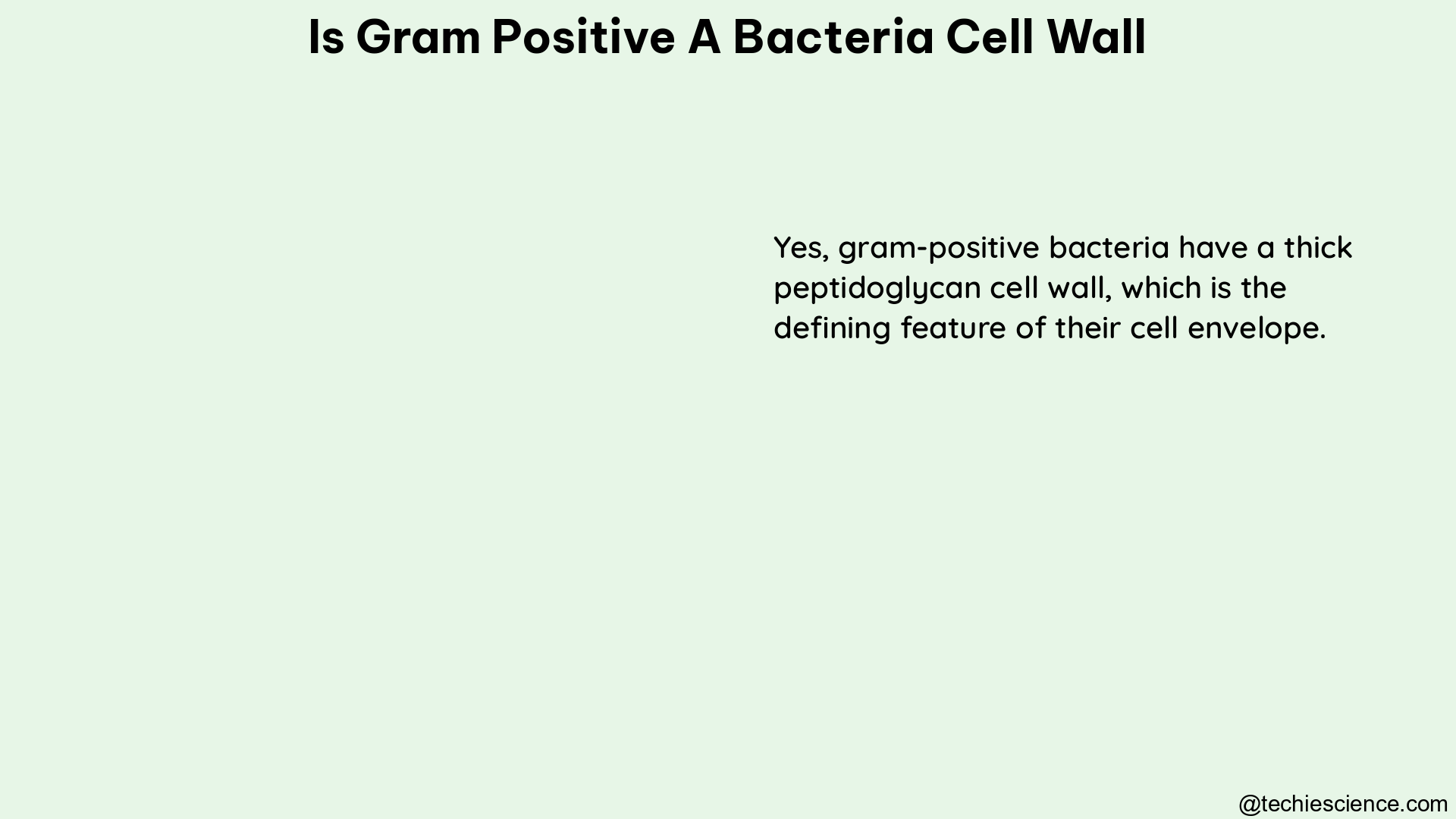Gram-positive bacteria are a fascinating group of microorganisms that possess a unique and robust cell wall structure, which sets them apart from their gram-negative counterparts. Understanding the intricacies of the gram-positive cell wall is crucial for various applications, from medical diagnostics to industrial biotechnology. In this comprehensive blog post, we will delve into the details of the gram-positive cell wall, exploring its composition, structure, and the techniques used to identify and differentiate these bacteria.
The Composition and Structure of the Gram-Positive Cell Wall
The defining feature of gram-positive bacteria is their thick peptidoglycan layer, which can account for up to 90% of the cell wall’s dry weight. This peptidoglycan layer is approximately 40 to 80 nanometers thick, significantly thicker than the 2 to 3 nanometer layer found in gram-negative bacteria. The peptidoglycan in gram-positive bacteria is composed of alternating N-acetylglucosamine (GlcNAc) and N-acetylmuramic acid (MurNAc) residues, which are cross-linked by short peptide chains.
In addition to the peptidoglycan layer, the gram-positive cell wall also contains other important components, such as:
-
Teichoic Acids: These are anionic polymers that are covalently linked to the peptidoglycan layer or embedded within it. Teichoic acids play a crucial role in maintaining cell wall integrity, regulating cell division, and facilitating the attachment of the cell wall to the cell membrane.
-
Lipoteichoic Acids: These are amphiphilic molecules that are anchored to the cell membrane and extend outward through the peptidoglycan layer. Lipoteichoic acids are involved in various cellular processes, including cell signaling, adhesion, and immune system interactions.
-
Proteins: The gram-positive cell wall also contains a variety of proteins, such as surface-associated enzymes, adhesins, and virulence factors. These proteins play essential roles in the bacteria’s interactions with their environment, host cells, and the immune system.
The absence of an outer lipid membrane is another distinguishing feature of gram-positive bacteria. In contrast, gram-negative bacteria possess a thin peptidoglycan layer sandwiched between an inner cell membrane and an outer lipopolysaccharide-rich membrane.
Techniques for Identifying Gram-Positive Bacteria

The Gram staining technique, developed by Hans Christian Gram in 1884, is the most widely used method for differentiating between gram-positive and gram-negative bacteria. During the Gram staining process, gram-positive bacteria retain the initial crystal violet stain, appearing purple or blue under a microscope. This is due to the thick peptidoglycan layer in their cell wall, which can effectively trap the stain. In contrast, gram-negative bacteria are unable to retain the initial stain and appear pink or red after the counterstaining step.
Another technique for distinguishing gram-positive and gram-negative bacteria is the use of the NaOH-SDS lysis solution, which is commonly employed in the plasmid extraction method for Escherichia coli. This solution effectively lyses gram-negative bacteria but not gram-positive bacteria, as the cell walls of gram-positive bacteria are more resistant to mechanical or chemical stresses.
The UF-1000i automated urine particle analyzer, which incorporates flow cytometry, is a powerful tool for rapidly and accurately detecting and counting bacteria in urine specimens. This analyzer has been evaluated in many facilities and has received high praise for its ability to differentiate between gram-positive and gram-negative bacteria based on their distinct cell wall structures.
The Significance of Gram-Positive Cell Wall Structure
The unique cell wall structure of gram-positive bacteria has important implications in various fields, including:
-
Medical Diagnostics: The Gram staining technique is a fundamental tool in clinical microbiology, as it allows for the rapid identification and differentiation of bacterial pathogens. This information is crucial for guiding appropriate antibiotic treatment and monitoring the progression of bacterial infections.
-
Antimicrobial Resistance: The thick peptidoglycan layer and the absence of an outer lipid membrane in gram-positive bacteria can contribute to their increased resistance to certain antibiotics and disinfectants. Understanding the cell wall structure is essential for developing effective antimicrobial strategies.
-
Industrial Biotechnology: Gram-positive bacteria, such as Bacillus and Streptomyces species, are widely used in industrial fermentation processes for the production of enzymes, antibiotics, and other valuable compounds. The cell wall structure of these bacteria can influence their growth, product yield, and downstream processing.
-
Immune System Interactions: The components of the gram-positive cell wall, such as teichoic acids and lipoteichoic acids, can interact with the host’s immune system, triggering specific immune responses. This knowledge is crucial for understanding the pathogenesis of gram-positive bacterial infections and developing effective immunotherapies.
Conclusion
The gram-positive cell wall is a remarkable and complex structure that plays a pivotal role in the biology and ecology of these bacteria. By understanding the composition, structure, and techniques for identifying gram-positive bacteria, we can gain valuable insights into their behavior, interactions, and potential applications in various fields. This knowledge is essential for advancing our understanding of microbial systems, improving medical diagnostics, and developing innovative strategies for combating gram-positive bacterial infections.
References:
- Technologynetworks.com. (2019). Gram Positive vs Gram Negative – Technology Networks. [online] Available at: https://www.technologynetworks.com/immunology/articles/gram-positive-vs-gram-negative-323007
- Ncbi.nlm.nih.gov. (2012). Rapid Discrimination of Gram-Positive and Gram-Negative Bacteria Using UF-1000i and NaOH-SDS Solution. [online] Available at: https://www.ncbi.nlm.nih.gov/pmc/articles/PMC3471971/
- Healthline.com. (2019). Gram-Positive Bacteria Overview, Interpreting Test Results – Healthline. [online] Available at: https://www.healthline.com/health/gram-positive

Hi, I am Saif Ali. I obtained my Master’s degree in Microbiology and have one year of research experience in water microbiology from National Institute of Hydrology, Roorkee. Antibiotic resistant microorganisms and soil bacteria, particularly PGPR, are my areas of interest and expertise. Currently, I’m focused on developing antibiotic alternatives. I’m always trying to discover new things from my surroundings. My goal is to provide readers with easy-to-understand microbiology articles.
If you have a bug, treat it with caution and avoid using antibiotics to combat SUPERBUGS.
Let’s connect via LinkedIn: